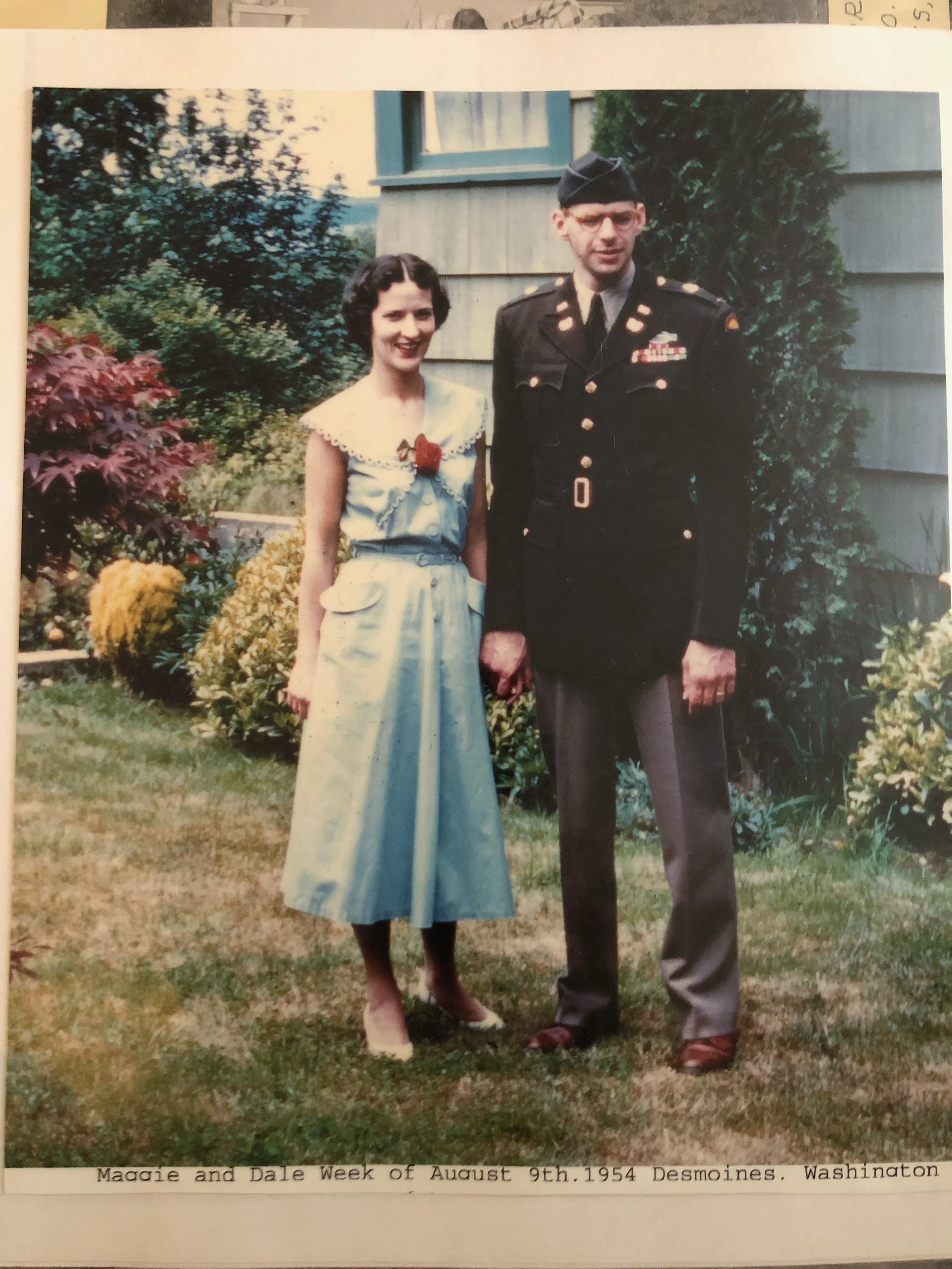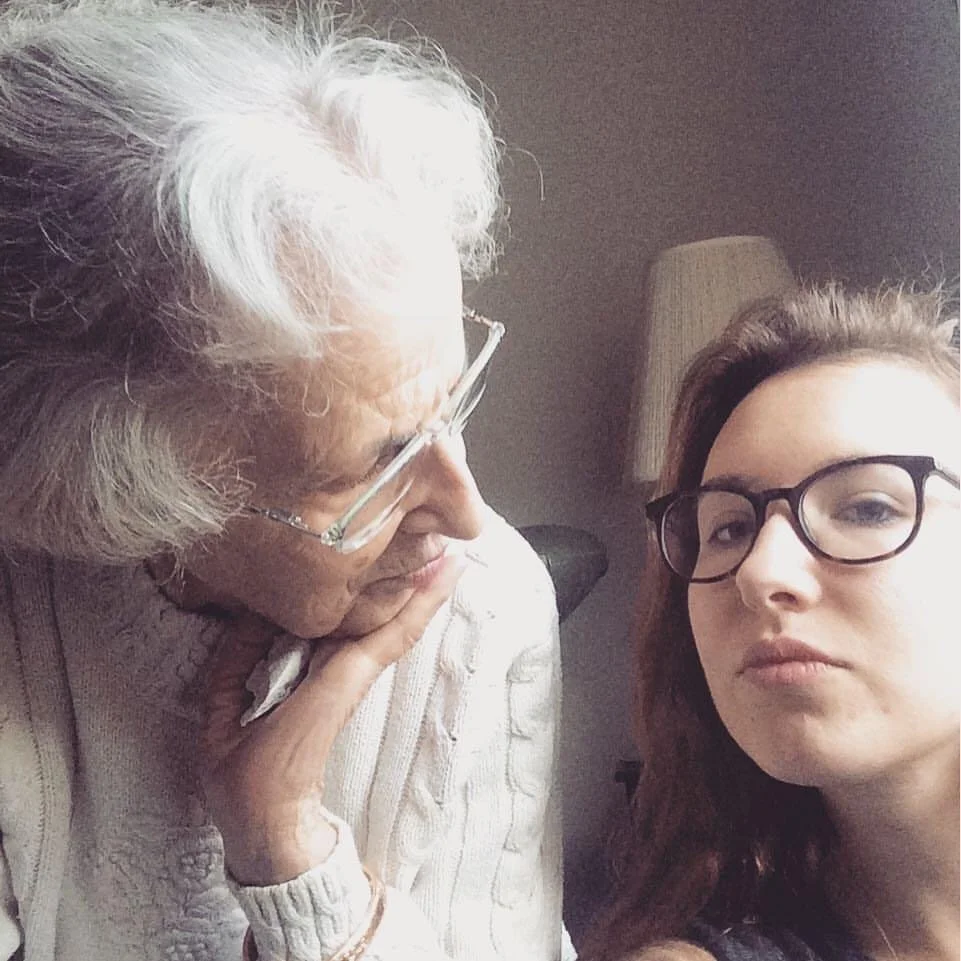margaret rages boyd
Margaret Isabel Rages Boyd was born the morning after a tornado on June 2nd, 1927, and grew up as the youngest of six children born into a farming family in Missouri during the Great Depression. Maggie was influenced by her four older sisters who all became music teachers, and her older brother who was sent overseas to fight in World War II when she was a teenager. Though her family lost their farm when they owed just $50 on their mortgage, they survived that era of devastation by focusing their efforts on education and on making music as a family.
“The more I think of it, the more I realize that music kept us alive. There was always music, if someone wasn’t plunking on the piano, they were singing.”
Maggie hopped up onto the bench of the family piano when she was about 3 and soon was playing in four part harmony. (Her first work, “The Cat Ate my Bird” was written when she was 4. ) She surprised her mother one morning in church by singing alto to her mother’s soprano only on intuition around the age of 4. In community gatherings and in “productions” at community events, Maggie was the default accompanist, playing sophisticated renditions of music she’d only heard once or so before.
There was never any money for lessons, and Maggie could never learn how to read music. However, she faked her way through music school, playing by ear and intuition, earning a Bachelor’s Degree in Music Education while playing the flute in orchestral ensembles. She met Dale Boyd at college (he had just come home from the war) and they were married within a year, at age 21 and 24 respectively.
Dale’s work as an Aerospace engineer took them from Seattle, WA to Nashua, NH, and then finally to Ann Arbor, Michigan, where they stayed until Dale’s passing of a heart attack at age 81 in 2005. Maggie lives at Chelsea Retirement Center in Chelsea Michigan, just 15 minutes away from the home of her youngest son Jon and daughter-in-law Pamela in Ann Arbor.
Musical abilities
Maggie’s life contains many of the things we look for in stories of musical “child prodigies”:
Ability to memorize music after hearing it once
Unusual musical abilities present from early age (<5 years old)
Having understanding of harmony “pre-programmed” (she started singing alto to her mother’s soprano at age 4)
Having an extraordinary memory for music (Music she wrote as an 8 year old is still at the forefront of her mind, and she can play any piece from the great American songbook by request.)
Some difficulties from an overactive internal aural imagination (Maggie has not been able to listen to music on the radio for decades: her brain overlays sound with harmonies.)
Difficulty with different areas of study: In the way that trying to read or write music has been “painful” for her, math has also been a shame-point for her, despite raising three sons who excelled in those very areas: her youngest was an electrical engineer who graduated summa cum laude at University of Michigan, her middle son has a masters degree in History and just retired after many decades as K-12 school Principal, and her oldest was head of Concept Car design at Ford Motor Company, and is one of the world’s experts on model cars.
Musical output
Despite having no financial or intellectual support for her musical abilities, Maggie spent her summers as an adult composing music. Her library of works is immense, totaling some ~50 works that we know of. These pieces all still exist, either in recorded form or in her mind. Some of them have been written down in simplistic form.
Maggie’s music is a wholly unique viewpoint; while the Gershwin brothers were writing catchy tunes about romance and rhythm, her oeuvre of 1940’s style popular songs gives a glimpse into the mind of an American, lower-middle-class, mid-century housewife’s experience. There’s just as much emotional turbulence, social commentary, romance and rhythm here, all encapsulated in the pithy prose and jazzy harmonies of a woman writing these as an outlet for the frustrations she had no other platform on which to speak them out loud.
These are lullabies written for her children, love songs, torch songs (breakup songs), pieces meant to be a some-day ballet, clever ballades written for the Rages family reunions, songs tracing family lineage, “complaint” songs that eloquently argued against sexism, like her Fight Song entry for the University of Michigan Marching Band’s song-writing contest entitled The Mighty Mrs. of Michigan—“I didn’t really give a fig about football but I wanted to give them something to think about”. She also wrote music about her hesitancy regarding the space race (like in Flight to the Moon, towards the end of this page), and about how she felt that her work as a mother and housewife was being looked down upon by “working” mothers (like in her song I’m Just a Footnote on my Mommy’s Resume).
legacy + search for answers
My grandmother is 95 years old. Though she now walks with the assistance of her purple walker, her wit and wisdom are sharper than ever. She plays her Aston-Weight upright piano every day and her apartment is a cornucopia of beautiful things she has created in her nearly century-long life. From the beautiful braid rugs that cover every inch of the floor to the artwork on her walls to the many, many books of her music and the sheet music of others, Maggie Boyd–a woman who never learned how to drive, who never learned how to read music, whose only “job” was as a housewife from the time she was 21–has been a prolific creator of innate beauty her whole life. She has come to terms with accepting her “other-ness”, holding out hope that some day someone would be able to help her have some answers about these things that have made her work extraordinary while at times making her life a bit more difficult.
As her granddaughter, and as one of her best friends (Maggie and I have spoken on the phone nearly every day for the past decade), I feel that as a composer, I have perhaps 3% of Maggie’s talent but I was born at a time when I could make good on those abilities and have a career as a woman composer. I feel very much as if I’m simply continuing her work.
EXAMPLES
10 minute
Oral History
compositions
flight to the moon
Flight to the moon
No astronomers' dream
Not a physicists scheme
I take a flight to the moon
No laws apply
No mighty motors
launch me from my source
Engineers never chart my course
as I take to the moon
A flight to the moon
No researching to do
Minus science or crew
I take a flight to the moon
no laws apply
No one has planned
this journey so grand
I take into the blue
A flight to the moon
the moment I look at you
- Margaret Rages Boyd
FLIGHT TO THE MOON
During the holidays of 2021, my grandmother asked me to write down a piece of music she had written in the 1950s as a love song for her aerospace engineer husband. I grew up among her compositions but this piece had never, to my memory, been shown to me before. And now I'm showing it to you. Something from the hands that made me, the hands that have existed as wrought, living, loving marbled porcelain for nearly a century. The hands that made this music yet never wrote it down, and the memory that kept it close for 70 years until it decided that the time was right to show it to me.
I've taken Margaret's two minute Flight to the Moon and brought it into my world for this work. We collaborated similarly on my sister's wedding march, in which my grandmother remembered a little song she wrote as a young girl mimicking the cry of a bird on her aunt's dairy farm in rural Missouri during the Great Depression. However, Flight to the Moon is the first piece of weight we've collaborated on across time as two Boyd women in their 30s.
American culture was orb-obsessed in their mid-century pursuits towards the sky to put man on the moon. Fly Me to the Moon (you've probably heard the Frank Sinatra version many times) was written in 1954, and my grandfather helped lunar pursuits during this time in his own small way, working for Boeing and Bendix with my grandmother dutifully in tow as his job made him move their young family several times around the country. I see Margaret's Flight to the Moon alongside Bart Howard's Fly Me to the Moon as a parallel take on this time. Here, we see her small defiances, perhaps the distilled frustrations of an artist whose deliberately un-technological livelihood was paid for by the space race. Ever practical, my grandmother much preferred a "flight into the blue" of my grandfather's bright blue eyes, and ever the obstreperous protest artist in her own right, I think that's where this song erupted from.
We are tremendously grateful to Carnegie Hall Ensemble in Residence Decoda Ensemble for giving the premiere of this piece
Lullaby
In my House of Fountains (2014), I orchestrated a melody from one of Margaret’s works, Lullaby. You can hear it begin at 7:20 in the recording.
House of Fountains (2014)
Program Notes I don't have many dreams that I remember, but one of the most beautiful ones I've ever had saw me walking into a forest clearing with my grandmother and seeing so many ancient water fountains, all flowing and sparkling, covered with moss and age. My grandmother and I are very close, and she is one of the most brilliant composers I know, though not many people have heard her music. After college she married my grandfather and became a mother, only composing in the summers—these beautiful Gershwin-like pieces— just for herself. In this dream she and I were looking for a house together, and this was the house we decided on, this magical clearing and all of its fountains. I like to think of each one of those fountains as a metaphor for the pieces she and I have both written: emblems of the continuity of creativity. For this piece I decided to use the orchestra as a palette on which to paint melodies I've created, and a take on my favorite melody of hers as well, so that the audience (and the performers!) may walk through an art gallery of melody in much the same way that she and I walked amongst the fountains in that dream.



